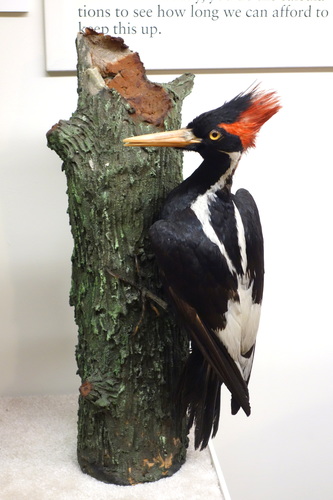
Ivory-billed Woodpecker
The Ivory-billed Woodpecker (Campephilus principalis) is a critically endangered, possibly extinct, woodpecker species native to the southeastern United States and Cuba. Renowned for its large size and striking appearance, it holds a near-legendary status among bird enthusiasts. Its ecological role was primarily as a specialist feeder on recently deceased trees, contributing to forest nutrient cycling. Culturally, the species has become a symbol of conservation and the devastating impact of habitat loss.
48-53 cm
Length
76-80 cm
Wingspan
Critically Endangered (Possibly Extinct)
Conservation Status
Distribution
Historically found in the southeastern United States, primarily in old-growth bottomland hardwood forests and longleaf pine savannas. A separate subspecies existed in Cuba. There have been no confirmed sightings for many decades, although unconfirmed reports persist.
Lifespan
Unknown, but estimated 15 years or more in the wild based on similar species.
Ivory-billed Woodpecker's Habitat
Habitat Types
Old-growth bottomland hardwood forests, Mature longleaf pine forests, Swamps
Climate Zones
Temperate, Subtropical
Adaptations
Strong bill adapted for excavating bark and wood to reach insect larvae. Large size likely aided in dominating feeding sites.
Variations
The Cuban subspecies (C. p. bairdii) was slightly smaller and had some differences in white markings.
Appearance
Breeding Plumage
No significant seasonal variation.
Seasonal Feather Changes
No
Sex Based Plumage Differences
Males have a red crest; females have a black crest.
Notable Features
Large size, among the largest woodpeckers in North America., Prominent ivory-colored bill., Black and white plumage with extensive white markings on the wings and back., Males have a striking red crest.
Diet and Feeding
Primary Foods
Wood-boring beetle larvae, Other insects, Nuts, Seeds, Fruits
Foraging Behavior
Primarily forages on recently dead or dying trees, scaling bark to access beetle larvae. Uses its powerful bill to excavate deep into the wood.
Specializations
Strong, chisel-like bill and a long, barbed tongue for extracting insects.
Seasonal Diet Variations
May consume more fruits and nuts in the fall and winter when insect availability is lower.
Behavior
Social Structure
Generally thought to be territorial and found in pairs or small family groups.
Communication
A distinctive, nasal "kent" or "pait" call, often described as sounding like a tin horn., Double-knock drumming pattern.
Migration
Non-migratory, but may have made local movements in response to food availability.
Territorial or Group Behaviors
Highly territorial, defending large areas of suitable habitat.
Conservation
Threats
Habitat loss due to logging of old-growth forests, Hunting (historical), Collection (historical)
Protection Programs
Extensive searches for surviving individuals, Habitat preservation efforts (though largely too late)
Local National Laws
Protected under the U.S. Endangered Species Act and similar legislation in Cuba.
Population Trend
Decreasing (possibly extinct)
Population Estimates
Possibly zero. No confirmed sightings in decades, despite extensive searches.
Interesting Facts
The Ivory-billed Woodpecker is often referred to as the "Lord God Bird" or "Good God Bird",
due to the exclamations people made upon seeing it.
It is one of the largest woodpecker species in the world.
Its impressive size and striking appearance have contributed to its legendary status.
The last universally accepted sighting in the United States was in 1944.
Although there have been numerous unconfirmed reports since then.
The call of the Ivory-billed Woodpecker is unique.
It's described as a single or double-note nasal 'kent' that is distinct from other woodpeckers.
Faqs about Ivory-billed Woodpecker
Is the Ivory-billed Woodpecker extinct?
Its status is officially listed as Critically Endangered, but it is widely believed to be extinct. There have been no confirmed sightings in many decades, despite extensive searches.
What caused the decline of the Ivory-billed Woodpecker?
The primary cause was the loss of its old-growth forest habitat due to logging. Hunting and collection also played a role in its historical decline.
Where did the Ivory-billed Woodpecker live?
It was historically found in the southeastern United States and Cuba, primarily in old-growth bottomland hardwood forests and mature pine forests.
What did the Ivory-billed woodpecker eat?
It specialized in feeding on wood-boring beetle larvae found in recently dead or dying trees. It also consumed other insects, nuts, seeds, and fruits.
Copyright @ Nature Style Limited. All Rights Reserved.
 English
English